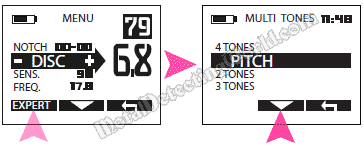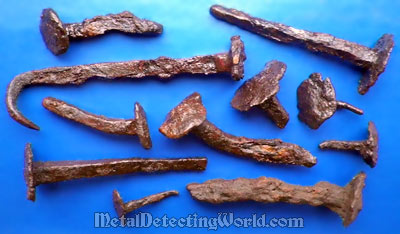XP Deus Program Settings, Features and Modes Explained, page 4
PITCH Mode of Discrimination: Function and Usability
The fourth option in the Discrimination's EXPERT sub-menu is Pitch which stands alone among other modes for its unusual function.

In this mode, the detector's audio response to any individual target ('good' or 'bad') varies in amplitude (volume) and tone pitch (audio frequency) as the response is generated not by the target's conductivity, but by the strength of the target's induced signal. In other words, the smaller or deeper the target, the weaker and lower in pitch an audio response to it.
Based on the signal strength, the function of the Pitch mode is similar to the Audio Response feature (described on page 12 of this article), with the only difference being that the latter maintains the tone pitch according to the target's conductivity value, not target's size or depth. The Pitch mode may be effectively used in conjunction with ample Conventional Discrimination (not Tonal Discrimination) when a single target (like a gold ring that has been lost during joyful rolling in tall grass) is sought and expected. The target will be easily located using the Pitch mode.
The Pitch mode can be also useful for relic hunting at the hunt site with a long history, such as an early-medieval settlement site that existed until modern times, and the ground surface has never been plowed. In this case, a cultural layer may be so thick (up to 1.5 m (5 feet)) that it is best to dig a test pit just to observe the multi-layer stratigraphy (up to four layers may be seen) and determine which historic layer consists of what desirable iron or bronze artifacts.
Usually the lowest layer has the best stuff while the upper layer has modern junk which is indicated by loud responses. Of course, the Deus would not be able to detect targets buried five feet deep, or detect deep targets through a dense layer of modern trash. Because of that, usually two feet of upper soil are removed to get access to the deeper cultural layers. And then, using the Deus' large 13" x 11" or even the 11-inch search coil in conjunction with a deep-seeking search program, one can get to valuable targets through 2.6 feet of soil.
Of course, removing two upper feet of soil is a hard physical labor and usually done only when digging a prospecting pit (or a few) is required after a "hot" coin spot is located. Removing the upper layers of soil is usually very well substituted by turning them up and mixing them by field plowing. This results in more coins becoming detectable every time the field is plowed and disc-harrowed. This is what makes a big difference between hunt sites hidden in the wooded remote areas and hunt sites that are periodically "refreshed" in the farm fields.
NOTE 1: In the v3.0 and subsequent versions, the Pitch can now be adjusted from 150 Hz to 600 Hz (page 36 of the Deus v3.0 User's Manual).
<NOTE 2: Before your ears get used to the detector's responses to different targets, it is recommended not to use low Conventional Discrimination which can cause a lot of confusing responses (iron falsing) to rusty nails with large heads and DEEP iron. And keep in mind that the detector's responses to large iron objects buried deep always include a high-pitched tone no matter how you set the Conventional Discrimination.

Hand-Wrought Nails with Large Heads Always Sound Off
with Both Low- and High-Pitched Tones
NOTE 3: If you utilize either 3-Tone or 4-Tone mode of the Multi-Tone feature, and you change an operational frequency in your search program during your metal detecting session, make sure some desirable targets do not "drop out" of the conductivity ranges you set for valuable targets (see details in "Frequency" chapter on page 7 of this article).